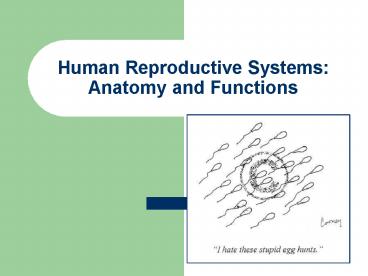Human Reproductive Systems: Anatomy and Functions - PowerPoint PPT Presentation
Title:
Human Reproductive Systems: Anatomy and Functions
Description:
Human Reproductive Systems: Anatomy and Functions Show this http://www.youtube.com/watch?v=FiIdsIUOGq0 Human Reproductive Systems Male Reproductive System Testes ... – PowerPoint PPT presentation
Number of Views:402
Avg rating:3.0/5.0
Title: Human Reproductive Systems: Anatomy and Functions
1
Human Reproductive SystemsAnatomy and Functions
2
Show this
- http//www.youtube.com/watch?vFiIdsIUOGq0
3
Human Reproductive Systems
- Male Reproductive System
- Testes
- Sperm Production
- Female Reproductive System
- Internal Anatomy
- Male/Female Comparisons
4
Vas Deferens
BACK
5
Vas Deferens
1-Testis2-Epididymis3-Vas Deferens
BACK
6
Acrosome
Nucleus
BACK
7
BACK
8
NEXT
BACK
9
BACK
NEXT
10
Fallopian tube
Fallopian tube
Uterus
Ovary
Ovary
Uterine Lining
Cervix
Vaginal Wall
BACK
11
BACK
12
Male PartsScrotum-sac of skin containing
testisTestis-contain a series of ducts that
produce sperm through meiosis temp of 35C/95
temp regulated by scrotum contracting/relaxing
from body body cavity-- also produces hormones
(testosterone)Epididymis-stores/matures
spermVas Deferens-after stimulation, sperm
highway from epididymis to urethraSeminal
Vesicle-produces nourishing fluid (fructose),
proteins, and other fluids for sperm to be
healthy (semen)Prostate Gland- It is about the
size of a walnut and encircles the urethra as it
leaves the urinary bladder. The secretions of the
prostate are thin, milky colored, and alkaline.
They function to enhance the motility of the
sperm. (semen) 1 cancer in men 40Ejaculatory
Duct-tube that delivers semen into urethra
Urethra-carries urine from bladder/semen out of
penisBulbourethral Gland (Cowpers)-produces
basic solution to neutralize in urethra from
urine and for harsh environment in acidic vagina
lubrication PenisSperm Acrosome- produces
enzymes to facilitate penetration of the egg
Sperm Nucleus-contains 23 chromosomesSemen-secr
etion from seminal vesicle, prostrate gland,
cowpers gland and sperm --Provides a watery
environment in which the sperm cells can swim
while outside the body --Provides nutrients for
the sperm cells (fructose, amino acids, vitamin
C) --Protects the sperm cells by neutralizing
acids in the female's sexual tract
Foreskin-protection against disease in old days
when not so clean irony now is that when left,
it allows infection to form if not taken care
of The volume of semen in a single ejaculation
may vary from 1.5 to 6.0 ml. There are usually
between 50 to 150 million sperm per milliliter of
semen. About 350 million per ejaculation. Sperm
counts below 10 to 20 million per milliliter
usually present fertility problems. Although only
one sperm actually penetrates and fertilizes the
ovum, it takes several million sperm in an
ejaculation to ensure that fertilization will
take place. Produce over 400 billion in
lifetime Takes approximately 70 days for a sperm
to fully develop. Continuous process produces
250-400 million sperm/day Sperm have lifespan of
3-5 days if in the proper environment
13
Female Parts Ovary-produces eggs and hormones
testes Fallopian Tube/Oviduct-egg highway to
uterus vas deferens fertilization happens
here Uterus-holds developing embryo/fetus/baby Vag
ina-birth canal muscular tube that receives
penis Labium majora-outer folds of skin oil
glands pubic hair scrotum labia Labium
minora-inner folds of skin oil gland/scent
production in some animals labia Clitoris-similar
to penis can be stimulated enlarges, erection,
very sensitive Urethra-carries urine only from
bladder note position when pregnancy Cervix-circu
lar ring of strong muscles separating vagina and
uterus cervical cancer mucousy before ovulation
to prevent infection, less sperm---watery when
ovulating Egg release cant be stimulated like
sperm Takes 5-7 days for egg tot ravel fallopian
tube to uterus. Within 24-48 hrs of ovulation,
egg dies if not fertilized. Egg has to be
fertilized in fallopian tube. -Oogenesis
process of development of mature unfertilized
eggs (ova) through meiotic divisions. -At birth
2 million primary versions of eggs that will
become mature eggs. -Unlike males, no more cells
that will become eggs will be produced after
birth. -Early versions of eggs remain suspended
in development until puberty and production of
FSH that triggers development by finishing
meiosis. -Only about 400 of the original 2
million primary versions will actually become
mature eggs. -Menstrual Cycle has two main
phases-gets eggs ready and send on way for
fertilization
14
(No Transcript)
15
http//science.tjc.edu/images/reproduction/female_
anatomy.htm --Egg Cycle Pics http//training.seer
.cancer.gov/module_anatomy/unit12_3_repdt_female.h
tml































